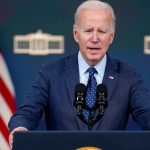
By Ambassador John Bolton
This article was first published in The Hill on February 18, 2023. Click Here to read the original article.
President Biden addressed the nation Thursday to discuss the Chinese high-altitude balloon recently flying over the United States and three other objects in North American airspace, all ultimately shot down by the U.S. Air Force. Biden’s apparent aim was to inform the public and justify his decisions regarding the presence of these vehicles in our skies.
He failed. Obviously unwittingly, Biden simply reinforced the view that his administration had disclosed only partial, highly selective elements of what the government already knew, essentially all of which were, unsurprisingly, consistent with the White House’s political narrative. His remarks sought to present the most innocuous interpretations of these recent events. Biden may have told the truth on Thursday, but not the “whole truth” and most certainly not “nothing but the truth.”
Biden’s briefing came the day after three officials of the Office of the Director of National Intelligence (“ODNI”) briefed me regarding the four recent overflights. The meeting, at DNI headquarters in Liberty Crossing, Va., lasted about an hour and was conducted in a cooperative, professional manner. During the briefing, I was shown pertinent documents, which ODNI retained, and I took no written notes.
A precondition for the briefing, reflected in standard government forms, was that I submit any materials intended for publication about the meeting to the National Security Council staff for prepublication review. That review’s purpose was to determine that my draft contained no classified information, and thereby receive assent to publish. I previously submitted my book “The Room Where it Happened” for clearance through this process which, in the regular order, it received, as has this article.
Prepublication review is a highly controversial practice, as I can attest; but critically, the review is confined to classification matters, not matters of policy, politics and opinion. Similarly, the ODNI briefing was on intelligence matters not the administration’s policy or its justification. There is a long-standing, entirely appropriate wall of separation between intelligence and policymaking, so it was right that the ODNI briefers did not (and should not) engage in policy advocacy.
Accordingly, responsibility for the failures, excuses and idle speculation about the four recent incidents lies with the White House’s political leadership. And Biden’s handling of the Chinese balloon was woefully inadequate, characterized by a far-too-benign view of Beijing’s intentions and capabilities. From the outset, the response was weak. The cognizant military official, Gen. Glen VanHerck, said on Feb. 6, “It was my assessment that this balloon did not present a physical or military threat to North America.”
That was manifestly incorrect, but Biden is sticking with it. His blindness toward Beijing’s threat could not be clearer. We certainly do not yet know everything about the Chinese balloon, but we do know through on-the-record administration statements, leaks from anonymous sources and congressional briefings that the balloon’s origin and approach to America were likely known long before the White House said it was first detected near the Aleutian Islands.
China lied, saying it was simply a weather balloon gone astray. Yet, no U.S. official has claimed Chinese authorities made any effort to contact Washington in advance to inform us or discuss how to handle the “wayward” balloon. Beijing either intended that it transit America or was at least willing to risk trying to get away with it.
For many years, U.S officials have worried about Chinese and other foreign intentions to destroy our communications and intelligence-gathering satellites in time of war or crisis.
If anti-satellite weapons could significantly impair our space-based capabilities, we would be severely disadvantaged. Could China’s high-altitude balloon program be a hedge against the destruction of its own satellites? Could this particular flight be a ploy to gain knowledge about our reaction to such overflights in time of peace? Should America consider having a comparable program, so we too have a hedge in a future crisis if our “eyes in the sky” are blinded?
Finally, Biden speculated about the other three objects shot down by the Air Force, stressing that there was no evidence these were of Chinese origin. Despite not yet having recovered the remains of any of those three targets, and lacking much evidence of any sort, Biden, following the path of his advisers and congressional supporters, was eager to say these objects were likely not dangerous.
Now, it may be that our Sidewinders destroyed a high school class’s missing science project. Or two or three. Or maybe not. Perhaps significantly, no business, academic institution or anyone else has come forward to say that their “object” is missing and that they are wondering whether their flying machine was one of the bogeys. Biden’s repeated efforts to de-emphasize the potentially dangerous implications of the incursions only risk confusion and embarrassment for himself and the country if the objects turn out to have more malign purposes. He should have stuck to “nothing but the truth.”
The ODNI briefing conclusively convinced me that we face a serious threat, from China at least, of lower-than-orbit surveillance above our territory. We once had an Open Skies Treaty with the Soviet Union to regulate overflights of our respective countries, which was routinely abused by Moscow. The U.S. withdrew from that treaty in 2020, after a process I helped launch before I resigned as national security advisor. We have never had such a treaty with Beijing, and there is no reason to negotiate an agreement they would undoubtedly violate.
Both the House and Senate have passed unanimous resolutions condemning the Chinese overflights, a rare display of bipartisanship in today’s Washington. Let’s get on with enhancing our national security against Beijing’s menace, not only from balloon flights but across the board.